Tree-Ring Reconstruction of Minimum Temperature Changes in the Northern Greater Khingan Mountains
Abstract
1. Introduction
2. Materials and Methods
2.1. Study Area
2.2. Collection and Processing of Tree-Ring Samples
2.3. Climate Data
2.4. Research Methods
3. Results
3.1. Chronological Characteristics
3.2. Response Analysis of Tree-Ring Chronology to Climate Factors
3.3. Reconstruction and Verification of the Minimum Temperature Sequence
3.4. Abrupt Climatic Changes in the Reconstructed Sequence
3.5. Characteristics of the Reconstructed Sequence
3.6. Periodicity of the Reconstructed Sequence
3.7. Spatial Correlations of the Reconstructed Sequence
4. Discussion
4.1. Response of Tree Radial Growth to Climatic Factors
4.2. Comparison with Other Reconstructed Results and Historical Events
4.3. Drivers of Climate Change
4.4. Limitations and Prospects
5. Conclusions
Author Contributions
Funding
Data Availability Statement
Acknowledgments
Conflicts of Interest
References
- Doran, R.; Ogunbode, C.A.; Böhm, G.; Gregersen, T. Exposure to and learning from the IPCC special report on 1.5 °C global warming, and public support for climate protests and mitigation policies. Npj Clim. Action. 2023, 2, 11. [Google Scholar] [CrossRef]
- Paris Agreement. Int. Leg. Mater. 2016, 55, 743. [CrossRef]
- Ripple, W.J.; Wolf, C.; Gregg, J.W.; Rockström, J.; Mann, M.E.; Oreskes, N.; Lenton, T.M.; Rahmstorf, S.; Newsome, T.M.; Xu, C.; et al. The 2024 state of the climate report: Perilous times on planet Earth. BioScience 2024, 74, 812–824. [Google Scholar] [CrossRef]
- Lu, X.; Jiang, Y. Advancements in studying the effects of climate change on forest ecosystems (No. 4). Resour. Econ. Res. Board 2023, 3, 151–177. [Google Scholar] [CrossRef]
- Zhao, Y. Vegetation and climate reconstructions on different time scales in China: A review of Chinese palynological research. Veg. Hist. Archaeobotany 2018, 27, 381–392. [Google Scholar] [CrossRef]
- Caetano-Andrade, V.L.; Clement, C.R.; Weigel, D.; Trumbore, S.; Boivin, N.; Schöngart, J.; Roberts, P. Tropical Trees as Time Capsules of Anthropogenic Activity. Trends Plant Sci. 2020, 25, 369–380. [Google Scholar] [CrossRef]
- Wang, Y.; Li, M. Research progress of dry-wet climate reconstruction by tree ring in China. Prog. Geogr. 2016, 35, 1397–1410. [Google Scholar] [CrossRef]
- Ren, M.; Liu, Y.; Cai, Q.; Li, Q.; Song, H.; Sun, C. Climate warming is significantly influenced by rising summer maximum temperatures: Insights from tree-ring evidence of the Western Tianshan Mountains, China. J. For. Res. 2024, 35, 63. [Google Scholar] [CrossRef]
- Jiang, S.; Liang, H.; Zhou, P.; Wang, Z.; Zhu, H.; Kang, J.; Huang, J.-G. Spatial and temporal differences in the response of Larix sibirica to climate change in the central Altai Mountains. Dendrochronologia 2021, 67, 125827. [Google Scholar] [CrossRef]
- Chen, F.; Gagen, M.H.; Zhang, H.; Chen, Y.; Fan, Z.; Chen, F. Warm season temperature in the Qinling Mountains (north-central China) since 1740 CE recorded by tree-ring maximum latewood density of Shensi fir. Clim. Dyn. 2021, 57, 2653–2667. [Google Scholar] [CrossRef]
- Wu, X.; Jiao, L.; Du, D.; Xue, R.; Wei, M.; Zhang, P. Elevation response of above-ground net primary productivity for Picea crassifolia to climate change in Qilian Mountains of Northwest China based on tree rings. J. Geogr. Sci. 2024, 34, 146–164. [Google Scholar] [CrossRef]
- Sun, L.; Cai, Y.; Zhou, Y.; Shi, S.; Zhao, Y.; Gunnarson, B.E.; Jaramillo, F. Radial Growth Responses to Climate of Pinus yunnanensis at Low Elevations of the Hengduan Mountains, China. Forests 2020, 11, 1066. [Google Scholar] [CrossRef]
- Shi, L.; Liu, H.; Wang, L.; Peng, R.; He, H.; Liang, B.; Cao, J. Transitional responses of tree growth to climate warming at the southernmost margin of high latitudinal permafrost distribution. Sci. Total Environ. 2023, 908, 168503. [Google Scholar] [CrossRef] [PubMed]
- Du, B.; Wang, Z.; Li, X.; Zhang, X.; Wang, X.; Zhang, D. Adaptation of Tree Species in the Greater Khingan Range under Climate Change: Ecological Strategy Differences between Larix gmelinii and Quercus mongolica. Forests 2024, 15, 283. [Google Scholar] [CrossRef]
- Shah, S.K.; Bhattacharyya, A.; Chaudhary, V. Streamflow reconstruction of Eastern Himalaya River, Lachen ‘Chhu’, North Sikkim, based on tree-ring data of Larix griffithiana from Zemu Glacier basin. Dendrochronologia 2014, 32, 97–106. [Google Scholar] [CrossRef]
- Yuan, Y. Variations of the spring precipitation day numbers reconstructed from tree rings in the Urumqi River drainage, Tianshan Mts. Over the last 370 years. Chin. Sci. Bull. 2003, 48, 1507. [Google Scholar] [CrossRef]
- Wang, Z.; Zhang, D.; Zhang, T.; Li, X.; Wang, X.; Luo, T.; Zhong, S.; Song, K. Reconstructing the Temperature and Precipitation Changes in the Northern Part of the Greater Khingan Mountains over the Past 210 Years Using Tree Ring Width Data. Forests 2024, 15, 1450. [Google Scholar] [CrossRef]
- Yun, R.; Jin, Y.; Li, J.; Chen, Z.; Lyu, Z.; Zhao, Y.; Cui, D. The annual rhythmic differentiation of Populus davidiana growth–climate response under a warming climate in The Greater Hinggan Mountains. Glob. Ecol. Conserv. 2021, 27, e01549. [Google Scholar] [CrossRef]
- Jiang, Y.; Wang, Y.; Zhang, J.; Han, S.; Coombs, C.E.O.; Escobedo, M.; Wang, J.; Wang, X.; Hao, L.; Li, G.; et al. Tree-ring reconstruction of June-July mean temperatures in the northern Daxing’an Mountains, China. Geochronometria 2020, 47, 13–22. [Google Scholar] [CrossRef]
- Wei, Y.; Ma, Y.; Sun, B.; Zhang, J. Reconstruction of historical runoff in the southern foothills of the Da Hinggan Ling Mountains based on Picea koraiensis. Arid Land Geogr. 2023, 46, 1269–1278. [Google Scholar]
- Palombo, C.; Battipaglia, G.; Cherubini, P.; Chirici, G.; Garfì, V.; Lasserre, B.; Lombardi, F.; Marchetti, M.; Tognetti, R. Warming-related growth responses at the southern limit distribution of mountain pine (Pinus mugo Turra subsp. Mugo). J. Veg. Sci. 2014, 25, 571–583. [Google Scholar] [CrossRef]
- Nagavciuc, V.; Roibu, C.-C.; Ionita, M.; Mursa, A.; Cotos, M.-G.; Popa, I. Different climate response of three tree ring proxies of Pinus sylvestris from the Eastern Carpathians, Romania. Dendrochronologia 2019, 54, 56–63. [Google Scholar] [CrossRef]
- Pritzkow, C.; Heinrich, I.; Grudd, H.; Helle, G. Relationship between wood anatomy, tree-ring widths and wood density of Pinus sylvestris L. and climate at high latitudes in northern Sweden. Dendrochronologia 2014, 32, 295–302. [Google Scholar] [CrossRef]
- Stokes, M.A. An Introduction to Tree-Ring Dating; University of Arizona Press: Tucson, AZ, USA, 1996. [Google Scholar]
- Holmes, R.L. Computer-Assisted Quality Control in Tree-Ring Dating and Measurement. Tree Ring Bull. 1983, 43, 51–57. [Google Scholar]
- Copenheaver, C.A.; Zink-Sharp, A. Fundamentals of Tree-Ring Research. Tree-Ring Res. 2014, 70, 161–162. [Google Scholar] [CrossRef]
- Warren, W.G.; LeBlanc, D.C. Dynamic standardization of tree-ring series. Can. J. For. Res. 1990, 20, 1422–1431. [Google Scholar] [CrossRef]
- Tayyab, M.; Muhammad, S.; Nawaz, H.; Ali, A.; Malik, S.M.; Waheed, M.; Rasool, K.; Khan, M.J.T.; Khan, Z.; Zahid, M. Climatically induced anomalies in tree-ring structure of Abies pindrow (Royal ex D. Don) and Taxus baccata (L.) growing in Hindu-Kush mountainous region of Pakistan. Environ. Res. Commun. 2023, 5, 065002. [Google Scholar] [CrossRef]
- Cook, E.R.; Krusic, P.J. Program ARSTAN: A Tree-Ring Standardization Program Based on Detrending and Autoregressive Time Series Modeling, with Interactive Graphics; Lamont-Doherty Earth Observatory, Columbia University: Palisades, NY, USA, 2005. [Google Scholar]
- Keyimu, M.; Li, Z.; Zhang, G.; Fan, Z.; Wang, X.; Fu, B. Tree ring–based minimum temperature reconstruction in the central Hengduan Mountains, China. Theor. Appl. Climatol. 2020, 141, 359–370. [Google Scholar] [CrossRef]
- Qiao, J.J.; Wang, Y.F.; Sun, Y.J.; Qiu, S.Y.; Xie, Y.H. Tree-ring based June mean temperature reconstruction over the past 140 years in the southern Lesser Khingan Mountains, northeastern China. Acta Ecol. Sin. 2023, 43, 8769–8779. [Google Scholar] [CrossRef]
- Jiachuan, W.; Shuheng, L.; Yili, G.; Yijie, H.; Zhonglei, M. Variation of mean maximum temperature from March to April since 1923 in the northern section of Lvliang Mountain recorded by tree rings. Arid Zone Res. 2023, 40, 337–348. [Google Scholar] [CrossRef]
- Martínez-Sifuentes, A.R.; Villanueva-Díaz, J.; Trucíos-Caciano, R.; López-Hernández, N.A.; Estrada-Ávalos, J.; Rodríguez-Moreno, V.M. A Reconstruction of May–June Mean Temperature since 1775 for Conchos River Basin, Chihuahua, Mexico, Using Tree-Ring Width. Atmosphere 2024, 15, 808. [Google Scholar] [CrossRef]
- Jing, Z.; Long, M.; Tingxi, L.; Bolin, S.; Zixu, Q. Reconstruction of the minimum temperature over the past 202 years based on tree rings of Picea crassifolia in the Helan Mountains. Arid Land Geogr. 2024, 47, 909–921. [Google Scholar]
- Wei, F.; Cao, H. Detection of Abrupt Changes and Trend Prediction of the Air Temperature in China, the Northern Hemisphere and the Globe. Chin. J. Atmos. Sci. 1995, 19, 140–148. [Google Scholar]
- Zhaopeng, W.; Tongwen, Z.; Yujiang, Y.; Ruibo, Y.; Shulong, Y.; Rui, L.; Shirenna, J.; Dong, G.; Yonghui, W. Comparative analysis of growth characteristics and climate responses in four coniferous tree species of southern Luoxiao Mountains. Chin. J. Plant Ecol. 2021, 45, 1303–1313. [Google Scholar]
- Yuan, Q.X.; Yu, S.L.; Jiang, S.X.; Qin, N.S.; Zhang, T.W. Tree-ring reconstruction of March-August drought variability over the past 567 years in the Yajiang region of West Sichuan Plateau, China. Chin. J. Appl. Ecol. 2021, 32, 3627–3635. [Google Scholar] [CrossRef]
- Dapao, Y.; Li, Z.; Limin, D.; Qingli, W.; Mingguo, L. Application of dendrochronology in global change research. Chin. J. Ecol. 2023, 6, 91–96. [Google Scholar]
- Vaz Monteiro, M.; Levanič, T.; Doick, K.J. Growth rates of common urban trees in five cities in Great Britain: A dendrochronological evaluation with an emphasis on the impact of climate. Urban For. Urban Green. 2017, 22, 11–23. [Google Scholar] [CrossRef]
- Junqiang, N.; Yujiang, Y.; Tongwen, Z.; Feng, F.; Ruibo, Z.; Huaming, S.; Shengxia, J. Reconstruction of early summer temperature during 1572—2014 from tree-rings in the Altay Prefecture. Arid Land Geogr. 2021, 44, 27–35. [Google Scholar]
- Henttonen, H.M.; Mäkinen, H.; Heiskanen, J.; Peltoniemi, M.; Laurén, A.; Hordo, M. Response of radial increment variation of Scots pine to temperature, precipitation and soil water content along a latitudinal gradient across Finland and Estonia. Agric. For. Meteorol. 2014, 198–199, 294–308. [Google Scholar] [CrossRef]
- Liu, Y.L.; Xin, Z.B.; Li, Z.S.; Maierdang Keyimu Yan, T.F. Response of radial growth of Pinus sylvestris var. mongolica to climate factors in Bashang area of Hebei Province. Acta Ecol. Sin. 2022, 42, 1830–1840. [Google Scholar]
- Shao, X. Reconstruction of precipitation variation from tree rings in recent 1000 years in Delingha, Qinghai. Sci. China Ser. D 2005, 48, 939. [Google Scholar] [CrossRef]
- Zhang, X.; Yang, L.; Liu, X.; Zhang, Q.; WANG, W.; Wang, X.; Wu, G. Study of the difference in climate response of Dahurian Larch and Pinus sylvestris growth in the north Great Higgnan Mountains of permafrost regions, Northeast China. J. Glaciol. Geocryol. 2017, 39, 165–174. [Google Scholar]
- Li, P.; Song, H.; Liu, Y.; Zhang, Q.; Fang, C.; Li, Q.; Cai, Q.; Zeng, X.; Ma, Y. Maximum July–August temperatures for the middle of the southern Tien Shan inferred from tree-ring latewood maximum densities. Int. J. Biometeorol. 2023, 67, 321–335. [Google Scholar] [CrossRef]
- Li, W.; Jiang, Y.; Dong, M.; Du, E.; Wu, F.; Zhao, S.; Xu, H. Species-specific growth-climate responses of Dahurian larch (Larix gmelinii) and Mongolian pine (Pinus sylvestris var. Mongolica) in the Greater Khingan Range, northeast China. Dendrochronologia 2021, 65, 125803. [Google Scholar] [CrossRef]
- Adriana, P.; Ernst, M.; Marieke, M.T.; Thomas, S.; Martin, W.; Juergen, K. Low resistance but high resilience in growth of a major deciduous forest tree (Fagus sylvatica L.) in response to late spring frost in southern Germany. Trees 2017, 31, 743–751. [Google Scholar] [CrossRef]
- Susanne, S.; Helena, M.H.; Pekka, N.; Samuli, H.; Tapani, R.; Mauri, T.; Harri, M. Connecting potential frost damage events identified from meteorological records to radial growth variation in Norway spruce and Scots pine. Trees 2017, 31, 2023–2034. [Google Scholar] [CrossRef]
- Shang, J.; Shi, Z.; Gao, J.; Xu, L.; Lü, S.; Feng, C.; Wang, L. Response of tree-ring width of Pinus sylvestris var. Mongolica to climate change in Hulunbuir sand land, China. Acta Ecol. Sin. 2012, 32, 1077–1084. [Google Scholar] [CrossRef]
- Chen, F.; Yuan, Y.; Wei, W.; Fan, Z.; Zhang, T.; Shang, H.; Zhang, R.; Yu, S.; Ji, C.; Qin, L. Climatic response of ring width and maximum latewood density of Larix sibirica in the Altay Mountains, reveals recent warming trends. Ann. For. Sci. 2012, 69, 723–733. [Google Scholar] [CrossRef]
- Fan, Y.; Shang, H.; Wu, Y.; Li, Q. Tree-Ring Width and Carbon Isotope Chronologies Track Temperature, Humidity, and Baseflow in the Tianshan Mountains, Central Asia. Forests 2020, 11, 1308. [Google Scholar] [CrossRef]
- Yu, J.; Zhou, G.; Liu, Q. Tree-ring based summer temperature regime reconstruction in XiaoXing Anling Mountains, northeastern China since 1772 CE. Palaeogeogr. Palaeoclimatol. Palaeoecol. 2018, 495, 13–23. [Google Scholar] [CrossRef]
- Duan, J.; Zhang, Q.-B.; Lv, L.; Zhang, C. Regional-scale winter-spring temperature variability and chilling damage dynamics over the past two centuries in southeastern China. Clim. Dyn. 2012, 39, 919–928. [Google Scholar] [CrossRef]
- Wang, Z.; Zhang, T.; Zhang, D.; Luo, T.; Wang, X.; Li, X.; Mao, H. Responses of Pinus sylvestris var. Mongolica tree ring width to climate factors at different elevations in the northern Greater Khingan Mountains. Dendrochronologia 2024, 83, 126166. [Google Scholar] [CrossRef]
- Shi, J.; Jin, Z.; Liu, Q.; Fan, T.; Gao, Z. Sunspot cycles recorded in Eocene lacustrine fine-grained sedimentary rocks in the Bohai Bay Basin, eastern China. Glob. Planet. Change 2021, 205, 103614. [Google Scholar] [CrossRef]
- Tei, S.; Yonenobu, H.; Suzuki, S.; Ohyama, M.; Gotanda, K.; Nakagawa, T.; Sugimoto, A. Reconstructed July temperatures since AD 1800, based on a tree-ring chronology network in the Northwest Pacific region, and implied large-scale atmospheric–oceanic interaction. Palaeogeogr. Palaeoclimatol. Palaeoecol. 2015, 435, 203–209. [Google Scholar] [CrossRef]
- Jiang, Y.; Liu, C.; Zhang, J.; Han, S.; Coombs, C.E.O.; Wang, X.; Wang, J.; Hao, L.; Dong, S. Tree ring width--based January–March mean minimum temperature reconstruction from Larix gmelinii in the Greater Khingan Mountains, China since AD 1765. Int. J. Climatol. 2021, 41, E842–E854. [Google Scholar] [CrossRef]
- Payomrat, P.; Liu, Y.; Pumijumnong, N.; Li, Q.; Song, H. Tree-ring stable carbon isotope-based June–September maximum temperature reconstruction since AD 1788, north-west Thailand. Tellus B Chem. Phys. Meteorol. 2018, 70, 1443655. [Google Scholar] [CrossRef]
- Wang, N.; Dee, S.; Hu, J.; Steiger, N.; Thirumalai, K. PDO and AMO Modulation of the ENSO–Asian Summer Monsoon Teleconnection During the Last Millennium. J. Geophys. Res. Atmos. 2024, 129, e2023JD039638. [Google Scholar] [CrossRef]
- Peng, Z.; Li, X.; Zhang, R.; Qin, L.; Zhang, H.; Chen, Y.; Liu, R. The response of tree-ring chronologies of Schrenk spruce (Picea schrenkiana Fisch. et Mey.) to climate change at high-and low-elevations of the eastern Tianshan Mountains, Xinjiang, using different detrending methods. Acta Ecol. Sin. 2019, 39, 1595–1604. [Google Scholar] [CrossRef]
- Sahar, H.M.; Mahmoud, B.; Pete, B.; Mansour, G. Uncertainty analysis of linear and non-linear regression models in the modeling of water quality in the Caspian Sea basin: Application of Monte-Carlo method. Ecol. Indic. 2025, 170, 112979. [Google Scholar] [CrossRef]


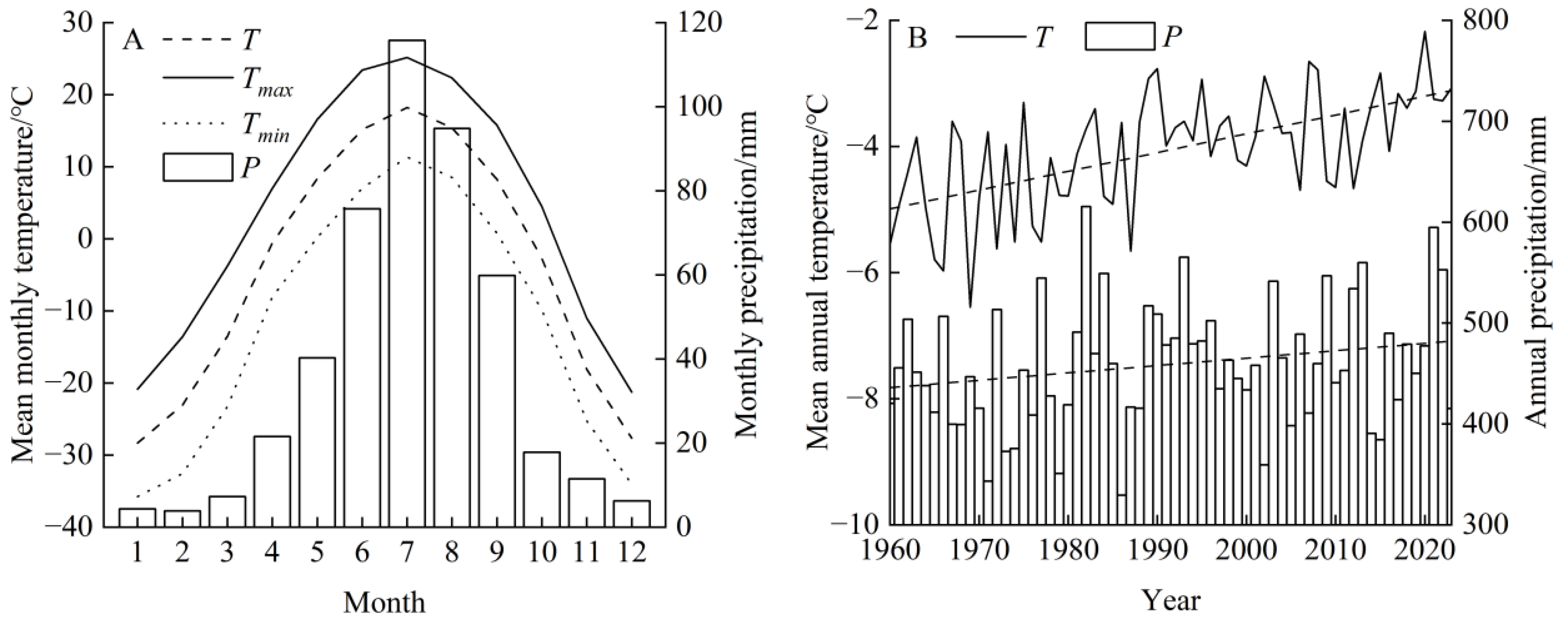
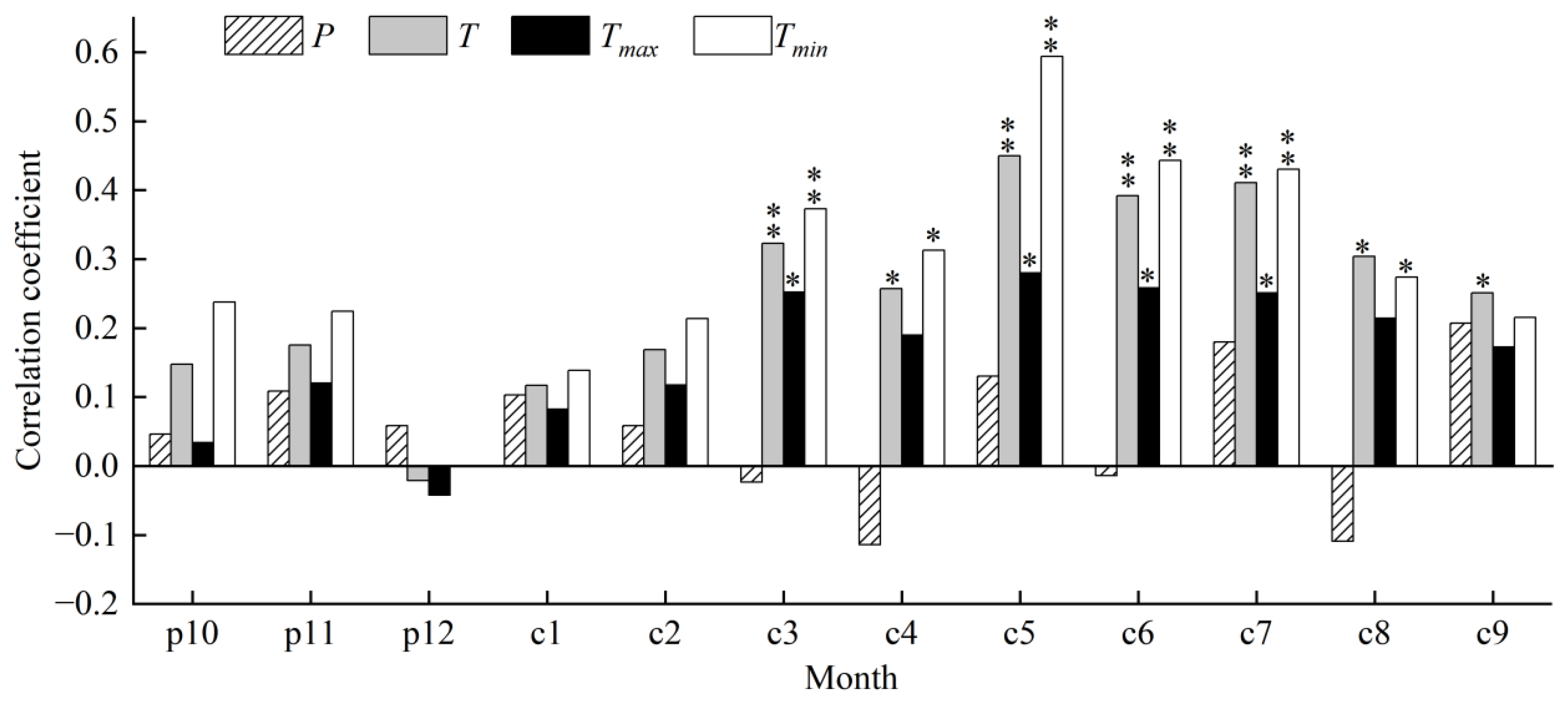
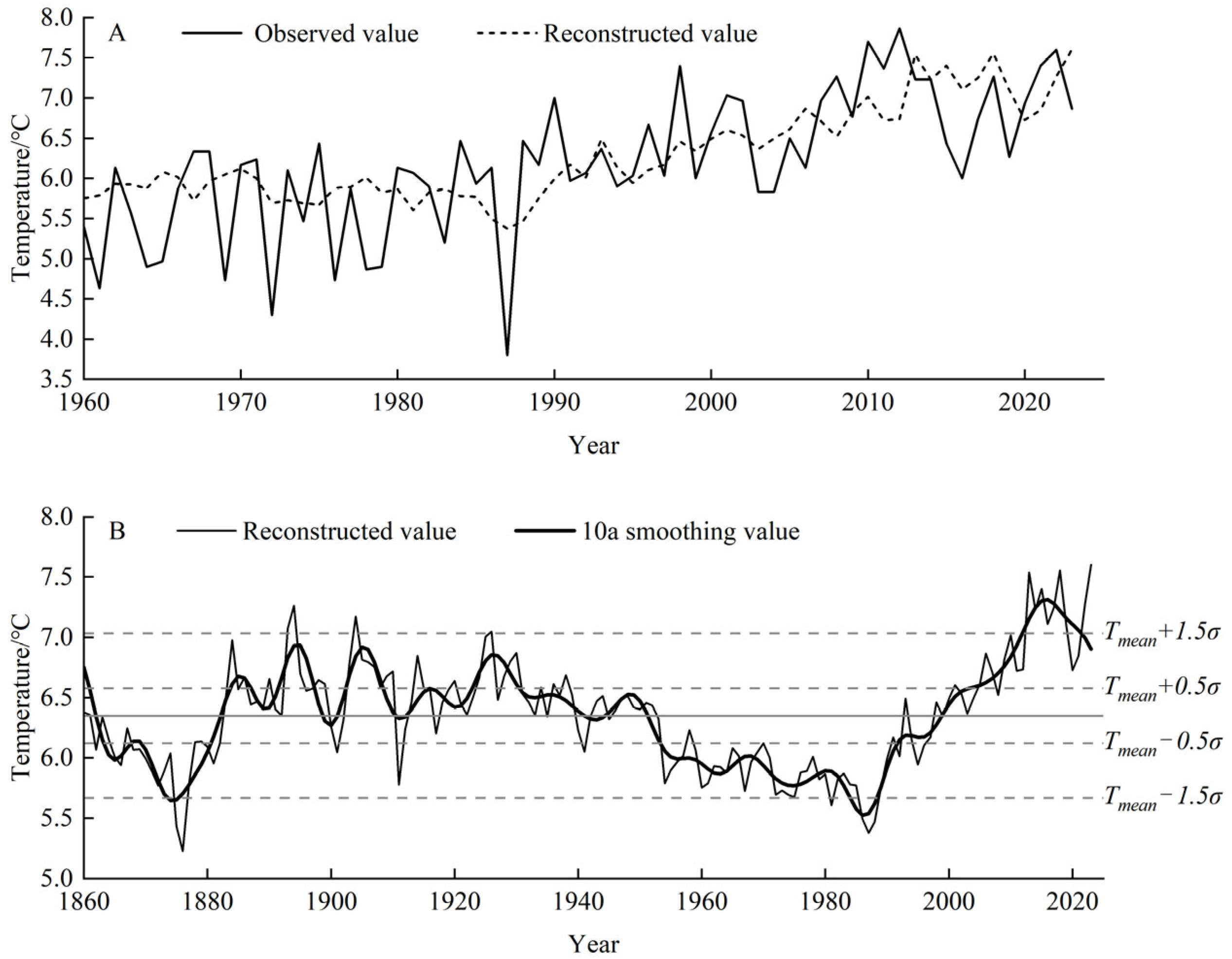
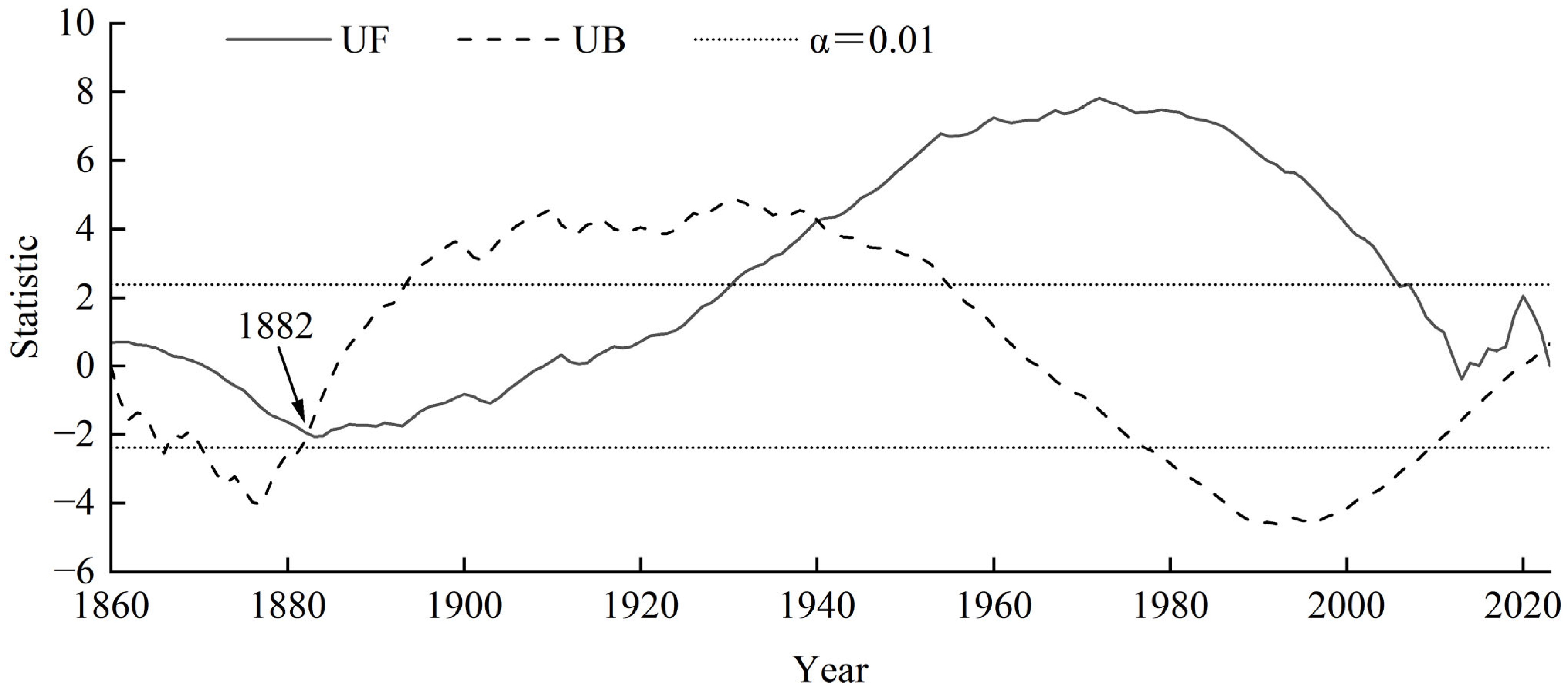


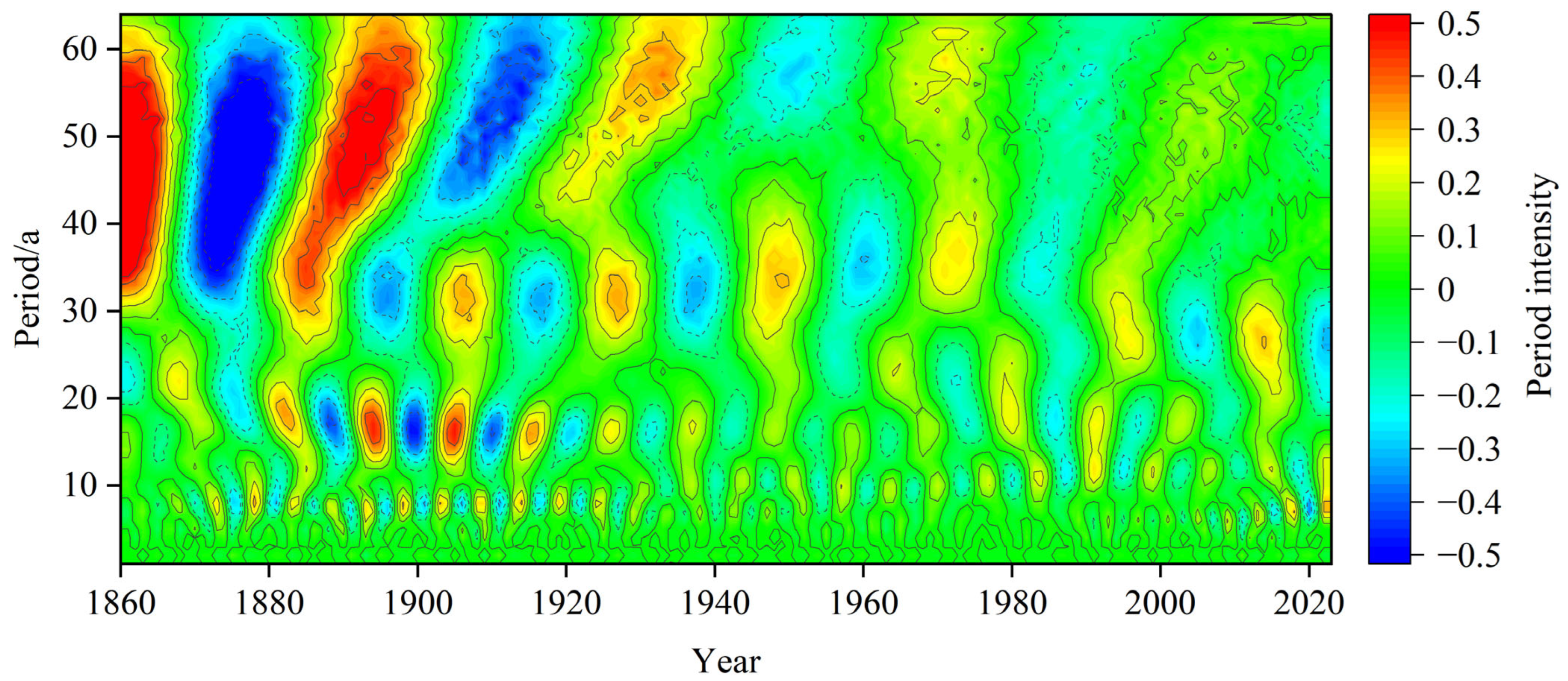
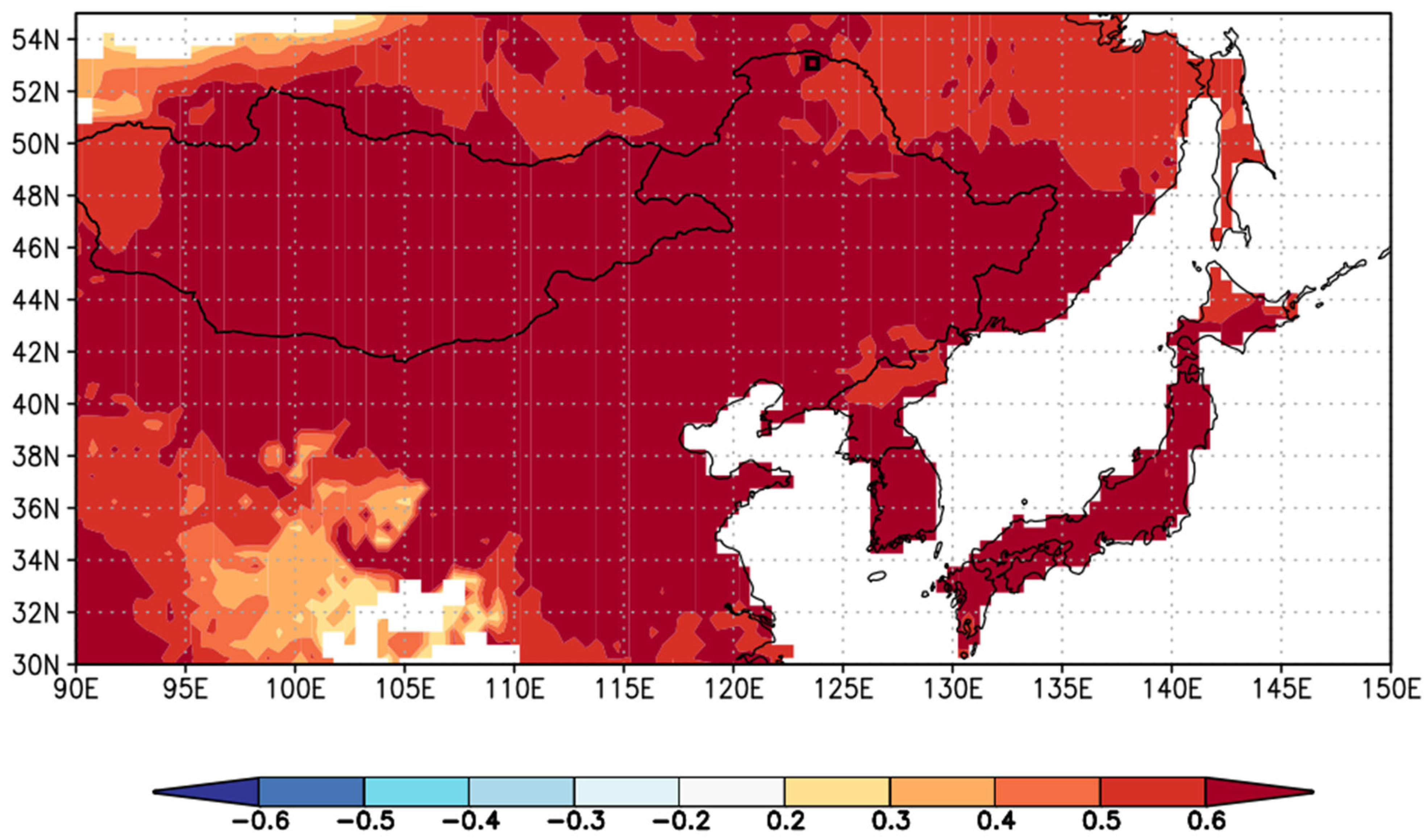


| Chronology Characteristic | Statistics | Chronology Characteristic | Statistics |
|---|---|---|---|
| Number of trees/cores | 22/46 | First-order autocorrelation | 0.814 |
| Mean sensitivity | 0.118 | Between-tree correlation | 0.466 |
| Standard deviation | 0.207 | Signal-to-noise ratio | 29.653 |
| First year of subsample signal strength > 0.85 | 1860 | Expressed population signal | 0.967 |
| Period | r | R2 | R2adj | F | RE | ST | t |
|---|---|---|---|---|---|---|---|
| 1960–2023 | 0.599 ** | 35.9% | 34.8% | 34.694 | 0.595 | 13/51 ** | 5.890 |
| Sequence Number | Average Period Length/a | Abrupt Change Year | |||
|---|---|---|---|---|---|
| 5 | 10 | 15 | 20 | ||
| 1 | 1882 | 1881–1882 | 1882 | 1882 | 1882 |
| 2 | 1930 | 1932 | 1932 | 1932 | 1932 |
| 3 | 1953 | 1953 | 1953 | 1953 | 1953 |
| 4 | 1971 | 1971 | 1971 | 1970 | 1971 |
| 5 | 1997 | 1999 | 1997 | 1997 | 1997 |
| Extreme Warm Year | Extreme Cold Year | ||||
|---|---|---|---|---|---|
| Year | Reconstruction Value/°C | Year | Reconstruction Value/°C | Year | Reconstruction Value/°C |
| 1893 | 7.07 | 2016 | 7.11 | 1875 | 5.43 |
| 1894 | 7.26 | 2017 | 7.25 | 1876 | 5.23 |
| 1904 | 7.17 | 2018 | 7.56 | 1981 | 5.61 |
| 1926 | 7.05 | 2019 | 7.10 | 1986 | 5.49 |
| 2013 | 7.54 | 2022 | 7.27 | 1987 | 5.38 |
| 2014 | 7.23 | 2023 | 7.60 | 1988 | 5.47 |
| 2015 | 7.40 | ||||
Disclaimer/Publisher’s Note: The statements, opinions and data contained in all publications are solely those of the individual author(s) and contributor(s) and not of MDPI and/or the editor(s). MDPI and/or the editor(s) disclaim responsibility for any injury to people or property resulting from any ideas, methods, instructions or products referred to in the content. |
© 2025 by the authors. Licensee MDPI, Basel, Switzerland. This article is an open access article distributed under the terms and conditions of the Creative Commons Attribution (CC BY) license (https://creativecommons.org/licenses/by/4.0/).
Share and Cite
Xu, J.; Wang, Z.; Zhang, D.; Li, X.; Du, B.; Wang, X.; Song, K.; Xie, Y.; Liu, Z. Tree-Ring Reconstruction of Minimum Temperature Changes in the Northern Greater Khingan Mountains. Forests 2025, 16, 1753. https://doi.org/10.3390/f16111753
Xu J, Wang Z, Zhang D, Li X, Du B, Wang X, Song K, Xie Y, Liu Z. Tree-Ring Reconstruction of Minimum Temperature Changes in the Northern Greater Khingan Mountains. Forests. 2025; 16(11):1753. https://doi.org/10.3390/f16111753
Chicago/Turabian StyleXu, Jiabao, Zhaopeng Wang, Dongyou Zhang, Xiangyou Li, Bingyun Du, Xinrui Wang, Kexin Song, Yuanhuan Xie, and Zhikuan Liu. 2025. "Tree-Ring Reconstruction of Minimum Temperature Changes in the Northern Greater Khingan Mountains" Forests 16, no. 11: 1753. https://doi.org/10.3390/f16111753
APA StyleXu, J., Wang, Z., Zhang, D., Li, X., Du, B., Wang, X., Song, K., Xie, Y., & Liu, Z. (2025). Tree-Ring Reconstruction of Minimum Temperature Changes in the Northern Greater Khingan Mountains. Forests, 16(11), 1753. https://doi.org/10.3390/f16111753





